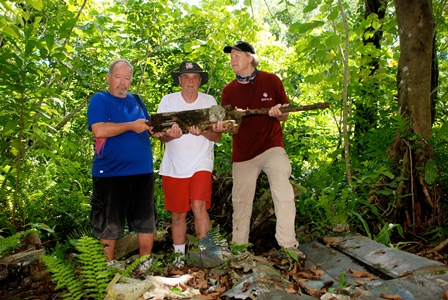Anderson Giles, Professor at the University of Maine at Presque Isle, has led dozens of trips focused on World War II in the Pacific over the years, but this time, he and his group had the unusual opportunity of visiting one of the most mysterious archeological sites in the Pacific, Nan Madol, the ancient city built on coral reefs.
Giles, a professor of art at the University, is passionate about the history of World War II and the veterans who served in the Pacific theater. He has worked for more than 20 years to preserve the history of the war in the Pacific through film, photographs, paintings and other collections, and has traveled to many islands in the Pacific—including Iwo Jima, Tarawa, and Peleliu—to document historical sites and interview World War II veterans about their experiences in order to preserve their memories for future generations.
On this trip, Giles directed a tour group of scholars, history buffs, and veterans on a tour through a number of Central Pacific Islands. They explored contemporary and ancient cultural and historic sites on the Islands of Pohnpei, Chuuk, Palau, and the Northern Mariana Islands, and they examined many prehistoric, Spanish, German and Japanese sites associated with those eras of occupation in addition to notable World War I and II sites.
One of the most intriguing adventures was a visit to Nan Madol, on the island of Pohnpei. The site has been labeled the ancient “Venice” of the Pacific because it was constructed in a monumentally conceived and executed project by an ancient race who built it around a system of canals. Nan Madol was built during the ancient Saudeleur Dynasty and served as a location for royal homes, burial sites, ritual activities, as well as important social, political, and religious functions.
Nan Madol is comprised of 92 artificial islands constructed of huge basalt columns quarried from large rock formations miles away from the site. It was the first city ever built atop of a coral reef and with its heavy stones, columns and some pillars as long as 30 feet and weighing over 35 tons, how it was built is still a mystery. Also a mystery is why the occupants abandoned the site sometime after 1200 A.D. Giles and his group were able to spend the better part of a day exploring the ancient tombs, walled temples and many other structures.
After leaving Pohnpei, Giles and the group spent time on the islands of Moen, Dublon, and Eten, which are a part of Truk Lagoon. Truk was the infamous Japanese “Pearl Harbor” of the Pacific. It was the home port of the Japanese combined fleet and thought to be impregnable. After repeated American attacks, over 60 ships lay sunken in its huge lagoon, which today has become one of the premier diving destinations in the world. Members of Giles’ group dove on some of these sunken ships and also explored the numerous impressive Japanese structures on the islands which are today being reclaimed by jungle.
Among the most interesting sites was the island of Eten, which the Japanese spent years cutting down into a huge island aircraft carrier. The group also hiked through thick jungle to examine seldom seen sites such as the Sapuk lighthouse complex and massive 8-inch gun emplacements.
Giles’ group next explored the islands of Palau. They visited Peleliu where one of the most savage battles of World War II took place. What was supposed to be a 3- or 4-day battle turned into a two-month-long bloodbath which shattered the 1st Marine Division. Giles’ group explored many remote Japanese cave and battle sites which were featured in three episodes of the recent HBO “Pacific” series, produced by Tom Hanks and Steven Spielberg. Giles discovered relics on the landing beaches and 50-caliber machine guns in a wrecked Corsair fighter in the jungle. These were donated to the Peleliu World War II Museum.
The group later explored the famous rock islands of Palau and visited many sites on the main Palaun island of Babelthaup. Among the most intriguing were the ancient stone face monoliths of Ngarchelong State. Of the 37 monoliths at the site, many have carved faces which still puzzle archeologists. These stones are very large, some weighing 7 tons, and were transported by unknown means from distant locations. Today, the stones are surrounded by numerous myths and local legends. They have become one of the major attractions for visitors and scholars to Palau.
To cap off the tour, Giles’ group visited the islands of Saipan and Tinian. They explored many of the World War II sites that Giles has studied for years and lectured on at commemorative and scholarly events. The group spent considerable time examining the facilities on Tinian associated with the atomic strike missions against Hiroshima and Nagasaki, which became the top news story of the 20th century.
“It was a remarkable and enlightening adventure exploring the mysteries and wonders of the ancient Pacific past as well as the more recent haunting ruins and relics of World War II battle sites,” Giles said.
